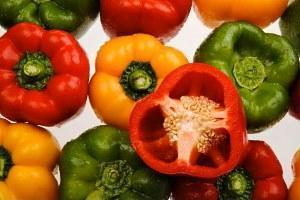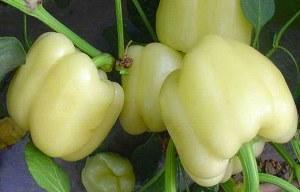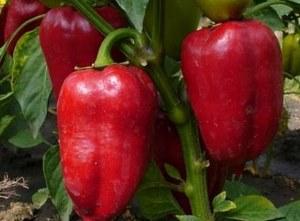We make our choice according to the photo with a description of the best varieties of sweet pepper
 There are many varieties of sweet (Bulgarian) capsicum. All of them differ among themselves not only in color, shape, thickness of the walls of the fruit and its size. Sweet peppers, whose varieties also differ in purpose and taste, are a thermophilic crop of the Solanaceae family. In the conditions of our country, its grown in seedlings... Many novice gardeners are wondering how to grow sweet peppers in the country?
There are many varieties of sweet (Bulgarian) capsicum. All of them differ among themselves not only in color, shape, thickness of the walls of the fruit and its size. Sweet peppers, whose varieties also differ in purpose and taste, are a thermophilic crop of the Solanaceae family. In the conditions of our country, its grown in seedlings... Many novice gardeners are wondering how to grow sweet peppers in the country?
The basis for success in the cultivation of this vegetable is the correct selection of its varieties and compliance with the requirements of agricultural technology. The best varieties of sweet peppers with photos and descriptions are presented below.
Sweet pepper varieties with photos
Breeders have developed many varieties of this crop. Its fruits, which are a multi-seeded false berry, have a variety of shapes: from proboscis to tomato (round). The color of the fruit can be: yellow, orange, green, red, purple and even almost white.
The following varieties are distinguished in sweet peppers:
- Early, which allow you to get a good harvest in a short time. These varieties are suitable for cultivation in northern latitudes. The most popular among them are:
- Swallow is a medium-early variety for greenhouses and film shelters. Fruits are conical up to 80 g. Wall thickness is 5-6 mm. In biological ripeness, the fruits are red.
- Snow White is an early ripe variety intended for film shelters. Conical fruits weighing up to 90 g. Wall thickness - 6-7 mm. In technical ripeness, the fruits have a characteristic whitish color, and in biological ripeness they are red.
 Madonna F1 is an early hybrid with cuboid fruits. Their mass reaches 200 g. The thickness of the walls is 6-7 mm. At biological maturity, the fruits are yellow.
Madonna F1 is an early hybrid with cuboid fruits. Their mass reaches 200 g. The thickness of the walls is 6-7 mm. At biological maturity, the fruits are yellow.- Dwarf is an early variety with a short stem (up to 40 cm) and conical thick-walled fruits (up to 80 g). In technical ripeness it is yellowish in color.
 Winnie the Pooh is an early variety with a small stem of 30 cm. Designed for open ground and film shelters. Its medium-sized fruits (up to 50 g) are distinguished by amicable ripening.
Winnie the Pooh is an early variety with a small stem of 30 cm. Designed for open ground and film shelters. Its medium-sized fruits (up to 50 g) are distinguished by amicable ripening.
- Mid-season, which are recommended to be grown in central Russia in greenhouses, and in the south - in the open. In suburban areas, the following varieties are used:
- Maria F1 is a high-yielding hybrid with a stem that reaches 85 cm in height. Fruits are flat-rounded, ribbed. Ripe peppers are red in color. The weight of the fruit is about 100 g, the wall thickness is 6-7 mm.

- Othello F1, a hybrid up to 80 cm high with cone-shaped fruits weighing up to 110 g and wall thickness of 7 mm. It has a beautiful purple color, which turns brown at the stage of biological ripeness.
- Tenderness is a productive variety for film shelters. Its stem grows to 120-140 cm. The weight of truncated-conical red fruits reaches 70-80 g. The thickness of their walls is 4-6 mm.
 Novogogoshary is a mid-early variety. Its standard plants grow up to 50-60 cm. Fruits of red color have a characteristic rounded-flattened shape. The mass of juicy, thick-walled fruits (8-11 mm) with proper agricultural technology reaches 120-140 g. The fruiting period of Novogosharov is 1.5 months.
Novogogoshary is a mid-early variety. Its standard plants grow up to 50-60 cm. Fruits of red color have a characteristic rounded-flattened shape. The mass of juicy, thick-walled fruits (8-11 mm) with proper agricultural technology reaches 120-140 g. The fruiting period of Novogosharov is 1.5 months.
Among the most common and popular varieties of sweet peppers, one should also highlight such as Victoria, Gift of Moldova, Crystal, Ruby, Novocherkassky 35, Kolobok, Gogoshary, Yubileyny 307, Myasisty 7, Swallow, Donetsk early, Large yellow, Bulgarian 79, Rotunda.
Growing sweet peppers
In the southern regions, it grows well in the open field, but in more northern latitudes, the greatest yield from pepper is obtained in greenhouse conditions. Sweet peppers have a herbaceous stem that grows stiff over time at the base. In places where the plant branches, single flowers appear.
Bell peppers are a self-pollinating crop, but sometimes insects pollinate them. The planting of bell peppers should be located away from the beds with hot peppers, as their mutual cross-pollination can occur, which leads to the appearance of a bitter taste in the fruit.
Bell peppers differ from other crops by their rather long growing season. The best varieties of sweet peppers (according to summer residents) are early-maturing varieties, in which the technical ripeness in the closed ground occurs approximately 100 days after germination. That is why this culture, both in the middle latitudes and in the south, is grown through seedlings. At the same time, seeds of early thick-walled sweet pepper are sown in boxes with a fertile soil substrate in early February.

Bell peppers are a rather demanding and thermophilic culture. Its seeds germinate fastest when the temperature is 25–27 ° C. These plants thrive best at 20–23 ° C. It is noteworthy that when the ambient temperature drops to 13 ° C, the seedlings of sweet peppers and even adult plants stop growing.
When the first leaves appear, the seedlings dive according to the 6x6 or 7x7 cm scheme into boxes or 1 plant per peat pots or plastic cups. Before planting in open ground, pepper seedlings are hardened for 7-10 days. It is best to plant plants with 7-9 formed leaves in a permanent place. Seedlings are planted in open ground only when the threat of spring frosts has passed, since it dies already at 0 ° C. Plants are planted in rows, the distance between which is 40-45 cm. The interval between peppers should be 30-40 cm. It can be reduced when planting compact, undersized varieties.
The beds for sweet peppers are fertilized in the fall. To do this, 4-5 kg of rotted humus are introduced into the soil or vegetable compost for 1 sq.m. plot or greenhouses... Apply 20-30 g to the soil complex mineral fertilizers for 1 sq.m. Such soil fertilization can be carried out a few days before planting seedlings in the spring.

To obtain the highest yield possible, timely care of plants and the creation of the most favorable conditions for them is required. Sweet peppers are planted in well-lit areas protected from the wind. With a lack of light, the plants stretch out and shed flowers and ovaries. The soil for this type of pepper should be fertile, light and neutral in acidity. It must be constantly hydrated. The lack of moisture greatly inhibits the growth of plants, therefore, without regular watering, they become dwarf, and the fruits - small and ugly.
Bell peppers are sensitive to excess nitrogen. At the same time, the plants quickly develop a green mass, but the number of flowers and ovaries decreases.
At the beginning of August, the tops of the stems are pinched and all the buds and flowers that do not have time to ripen before the onset of autumn are removed. After 10-15 days, the operation is repeated. During the growing season, tall peppers are tied to stakes or trellises 2-3 times.
To feed sweet peppers, use diluted bird droppings or a mixture of mullein with superphosphate... You can also feed with phosphorus-potassium fertilizers.
During the growing season, it is necessary to regularly remove weeds and loosen the soil. Sweet peppers can be harvested unripe (at the stage of technical ripeness). In the phase of biological ripeness, they contain more sugar, but if you wait for the fruit to fully ripen on the bush, then the total yield will be much lower.
Sweet pepper varieties for the Moscow region
 Many summer residents want to start growing sweet peppers in their summer cottages, but they do not know which varieties to choose for this or that region.
Many summer residents want to start growing sweet peppers in their summer cottages, but they do not know which varieties to choose for this or that region.
There are many varieties of this crop that are successfully grown in the Moscow region.Moreover, some early-maturing hybrids and traditional varieties manage to ripen even when grown in open ground.
According to many summer residents, the following varieties of bell pepper are most suitable for this region:
- Reds: Rhapsody, Winnie-the-Pooh, Agapovsky, Bogatyr, Viking, Merchant, Swallow, Kakadu F1, Kolobok, Atlant, Red shovel, California miracle, Claudio F1, Chardash, Funtik, Buratino F1.
- Yellow: Apricot Favorite, Bugai, Yellow Bell, Gemini F1, Gold Reserve.
- Purple: Big Daddy, Bagheera.
- Orange: Orange Wonder, Siberian Bonus, Cow's Ear.

All of these varieties differ in color and shape of the fruit, the size of the bush, but all of them are characterized by rapid ripening.

Sweet pepper varieties for Siberia
Since sweet peppers are a thermophilic crop, hybrid varieties are grown in the climate of Siberia that are maximally adapted to the conditions existing there. The best results are obtained by cultivating it in greenhouses and greenhouses. To obtain good yields in Siberia, only early varieties are used:
- Reds: Firstborn of Siberia, Winnie-the-Pooh, Early miracle, Agapovsky, Alyosha Popovich, Viking, Merchant, Swallow, Korenovsky, Kolobok, Atlant, Novosibirsk, Krasnaya spade, Chardash, Belozerka, Funtik, Topolin, Red giant.
- Orange: Siberian bonus, Orange miracle.
All of the above varieties are suitable for growing under a film cover. They mature in just 70-80 days.
For many years, I grew bell peppers according to the principle "so that it was like everyone else's" a few bushes and was not interested in agricultural technology. The harvest was appropriate. Until a neighbor in the country, a Ukrainian woman did not suggest how to properly care for him. Even in a greenhouse, it turns out that from the heat it needs to be slightly shaded with non-woven material. Water often, but not much. He loves organics very much. Herbs infused, mullein, chicken guano was added during watering once every two weeks. As a result, the peppers were thanked with a good harvest. And then she sowed the seeds of large peppers from the southern region. I got two peppers on each bush. Past again. Now I know for sure that only zoned varieties need to be planted. In the article, by the way, they are listed. When growing, do not create drafts, peppers do not like it. Each culture requires a different approach.